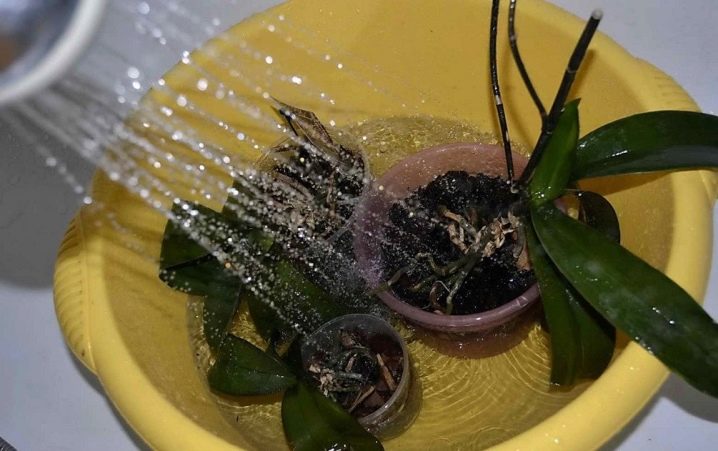Watering errors
Watering an orchid is a very important part of caring for it. Often it is errors in watering that harm the plant and even provoke its death. Therefore, when caring for an orchid, you should familiarize yourself with possible errors in watering:
- Overflowing. This is the most common mistake made by florists. The plant does not tolerate excess moisture, since stagnant water in the pot leads to root rot. This can be prevented by using a high drainage of foam plastic - it should be at least 4 cm.Using gravel or expanded clay, there is a risk of infection with a polytails, because this is a favorable environment for it.
- Water ingress into the leaf axils. If you water the flower inaccurately or do not remove moisture from the leaf axils after that, then the water leads to decay of the root collar of the flower, which causes it to die.
- Spraying from a distance of less than 20 cm. If the procedure is carried out from a closer distance, the moisture will evaporate more slowly. Large drops on flowers, which are there for a long time, make them lethargic and faded. As a result, dark spots remain on the leaves, which over time become like dents.
- Poor quality water. When cold, hard or just dirty water is used, orchid leaves quickly turn yellow and the root system dies.
- You can not spray the plant if it is in direct sunlight for a long time: there is a risk of leaf burns.
- Winter spraying is also undesirable, because the leaves are cooled and an ideal environment for the development of diseases is formed.
- Using the immersion method, it is necessary to change the water after each pot so as not to infect all the plants if it turns out that one of them is already affected by a fungus or parasites.
By following these simple recommendations, you can get a healthy and flowering plant as a reward, delighting the eyes of the owner with its beauty.
Watering orchids for different types of it has small or significant differences.
When choosing a flower for yourself, you should pay attention to unpretentious plants in the care, so as not to spend a lot of time on this and not resort to various tricks for proper cultivation. The exact recommendations for watering the selected variety can be obtained from a specialist - a florist of a flower shop.
Features of watering orchids
It is recommended to water this plant only after the soil in the pot is completely dry. This is a basic rule that must not be violated.
Air temperature and humidity, pot size, lighting are decisive factors for the watering regime of orchids.
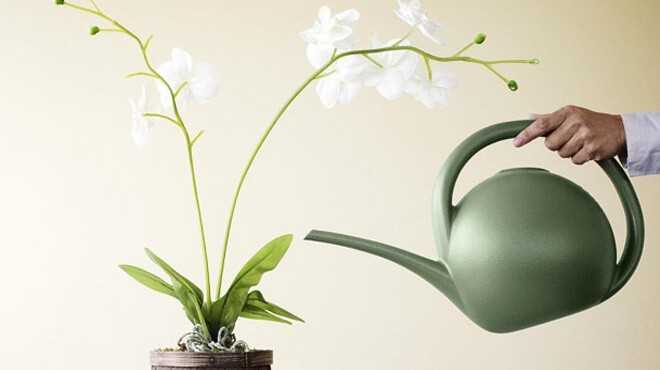 How to water an orchid photo
How to water an orchid photo
Waterlogging will lead to the death of the flower, the roots will not be able to receive oxygen with an excess of moisture. If it is cloudy or raining outside, watering should also be reduced, orchids are able to absorb moisture that is in the air.
Irrigation water
Water quality plays an important role in plant care. If it is not possible to collect rainwater, it is necessary to bring tap water as close as possible to its composition. Phalaenopsis is watered with warm, soft water, because in nature the flower is accustomed to rainwater. At home, ordinary tap water is defended for two days, it can also be passed through a filter and softened with oxalic acid, the main thing is not to overdo it.
It is not recommended to use distilled water for irrigation, it is devoid of salts, it is necessary to mix it with settled water. You can use ordinary boiled water, it is even better than settled water, since it is devoid of microflora. The main thing is that the water should be warm, not lower than 35C.
How often to water an orchid
Short answer: It is recommended to water the orchid once a week, if the flower is located in a cool place, you can do this at intervals of 10 days. The plant is often watered during the flowering period, after transplantation and during the hot season.
If not properly watered, the orchid can get sick or die. Thanks to the unusual roots, the plant can store a sufficient amount of moisture.
Excessive watering causes stagnation of moisture in the pot and rot of the root system, this leads to the death of the flower. Water the orchid regardless of the time of day, if the flower is shaded from the sun. If the flowers are on the loggia, it is better to water it always in the morning. This is due to the difference between night and day temperatures. During the day, the substrate will have time to dry out, and at night the orchid will not suffer from the coolness of the night.
Factors playing a role in watering frequency:
- season;
- life cycle of an orchid;
- climatic conditions of the room (temperature, humidity, lighting);
- growing method and composition of the substrate.
It is recommended to water the orchid once a week, if the flower is located in a cool place, you can do this at intervals of 10 days. The plant is often watered during the flowering period, after transplantation and during the hot season. To check the moisture content of the substrate, you can gently insert a wooden stick into the pot and see if it is dry or not.
When to limit watering
Limit watering if it is necessary to make the phalaenopsis bloom in the winter. If in February the flower is removed to a darker place with a cool temperature not higher than 16C and watering is reduced to a minimum (once every 10-15 days), it will bloom. Flowering will last until early summer.
Some types of orchids (dendrobiums, cattleyas, oncidiums) need a dormant period. Therefore, in October, watering is gradually reduced, and since December, the plant is watered once a month. In spring, the moisture becomes more intense.
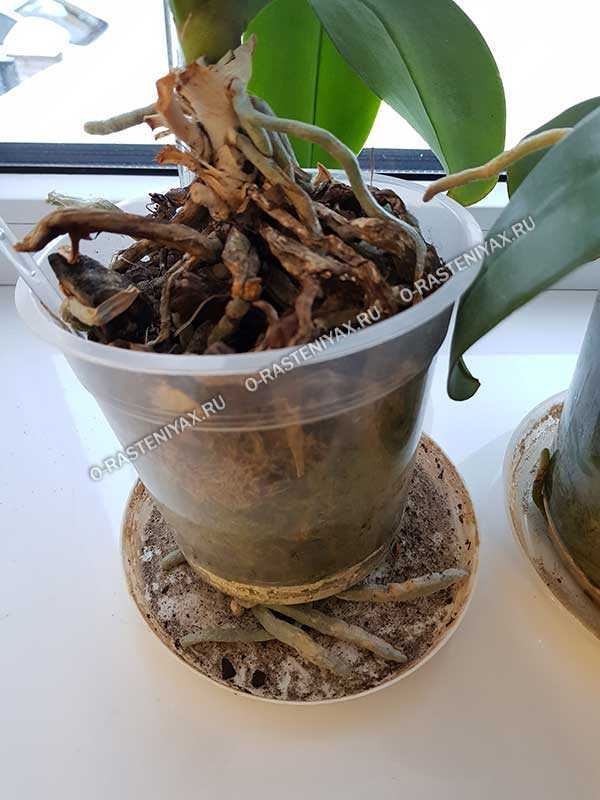 Orchid roots photo
Orchid roots photo
To correctly determine the beginning of the dormant period, it is necessary to examine the aerial roots of the orchid. If the flower leads an active lifestyle, the roots are green and saturated with moisture, if the dormant period has begun, the roots become white, tightened with velamen.
How not to water
To avoid stagnant water, foam balls can be used as a drainage layer, and they need to be poured at least 4 cm in the pot. Watering orchids should be done carefully so that no water remains in the leaf axils. Otherwise, there is a risk of decay of the root collar and death of the plant.
Phalaenopsis should not be watered and sprayed with poor quality water, the leaves will begin to turn yellow and fall off, which will lead to the death of the flower.
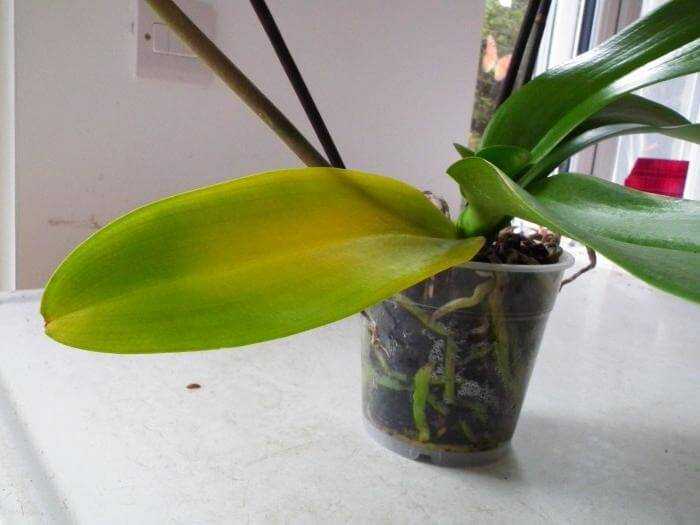 Orchid leaves will begin to turn yellow and fall off.
Orchid leaves will begin to turn yellow and fall off.
If watering the orchid by immersion is used, you can not use previously used water, each time you should pour a new one into the basin. In addition, there is a risk of contamination of healthy plants after watering sick ones.
Orchid care basics
When caring for a plant, certain requirements must be observed:
- Light mode. The plant loves light (with the exception of direct sunlight). The best option is a distance of no closer than one meter to the window. If there is not enough light for the flower, then the leaves will have active growth, and the "dormant" buds will not bloom.
- Humidity mode. Since orchids are tropical plants, high humidity is one of the conditions for their normal growth. Dry indoor air can cause leaf wilting.
- Temperature conditions. The most favorable temperature for a flower is + 17 ... + 23 degrees. Excessive heat adversely affects its flowering: this period is significantly reduced.
- Correct watering. Abundant watering can lead to rotting of the root system and dropping of buds. For irrigation, you need to use settled water not lower than +35 degrees.
- Fertilizers. Top dressing should be carried out no more than once every 7-10 days (flowering period) with fertilizers, which include potassium, nitrogen, phosphorus.
- A change of scenery. The plant is not recommended to be rearranged from place to place, especially during the flowering period.
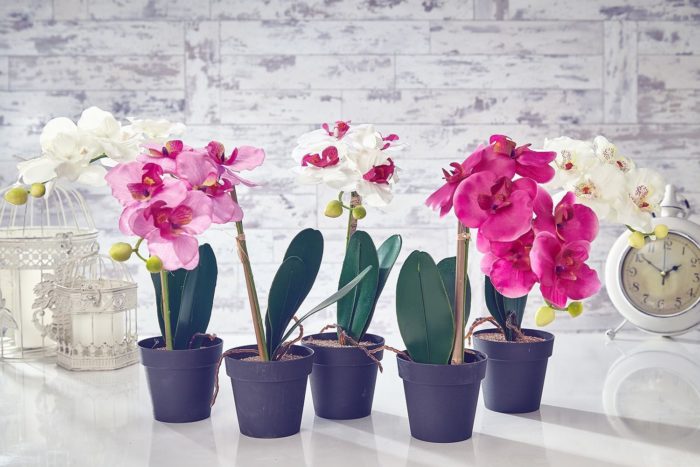
Peculiarity! The duration of flowering is influenced by the age of the orchid. Good peduncles are formed in a plant that is 1.5–3.5 years old.
What water and how often should you water your home orchid?
If you water the orchid with ordinary tap water, then this tropical and rather pampered plant will quickly fade away and, of course, will not please you with colorful flowering. Therefore, caring owners need to take care of the quality of water to moisturize the orchid.
In this case, pay attention to the following parameters:
- the temperature for watering - should be about thirty-five degrees, it can be higher, but not lower at all, since the plant is extremely thermophilic;
- acidity level (pH) - should not exceed 5, it can be reduced by adding lemon juice to the water;
- softness - tap water has a fairly high hardness, which is detrimental to orchids, it can be softened with oxalic acid (0.5 tsp per 5 liters of water) or with a purifying filter.
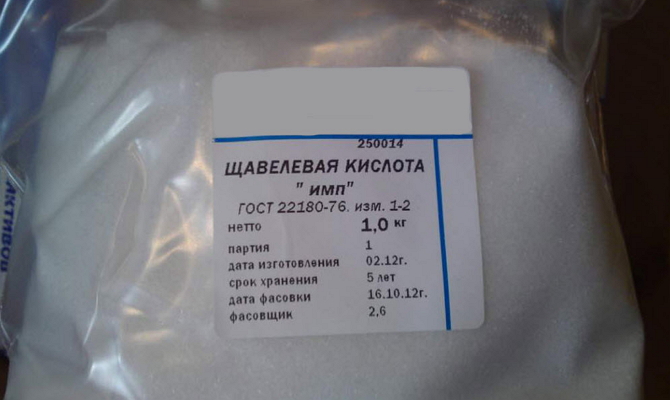
Oxalic acid to soften tap water
It is almost impossible to give an unequivocal answer how many times a week or month you need to water an orchid. The mode and frequency are selected individually. This is primarily due to the rate of drying of the soil, substrate, as well as the root system of the flower. And this depends on a number of other accompanying factors. These include:
- degree of lighting;
- the size of the pot;
- air temperature;
- the size of the substrate - it is believed that the large substrate dries faster, and the small one retains moisture longer;
- the degree of exposure to sunlight;
- general humidity level;
- Atmosphere pressure;
- the composition of the substrate - for example, sphagnum moss or coconut chips retain moisture much better than, say, pine bark.
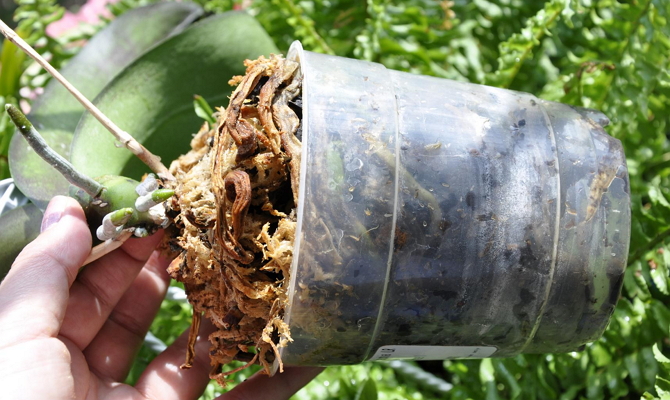
The state of the plant root system
You can draw up an individual watering schedule with the help of careful observation of the orchid. Make sure that the soil does not dry out and that the ground always remains slightly damp. However, experienced flower growers argue that overflow is more terrible for an orchid than underfilling. With excessive moisture, the roots of the plant begin to rot, which leads to its early death. You can determine if a flower needs watering thanks to a simple test. Use your finger to touch the soil in which your indoor orchid grows. If the soil remains dry at a depth of three centimeters, this means that it is dry and the plant needs moisture.
Watering the orchid during flowering at home
Peculiarities
How often to water a blooming orchid depends on environmental factors:

How often you water your orchids depends on many factors.
One of the popular topics on the forums of orchidists is "My orchid is blooming, how to water?" To determine the answer to this question, first, let's figure out some of the watering rules:
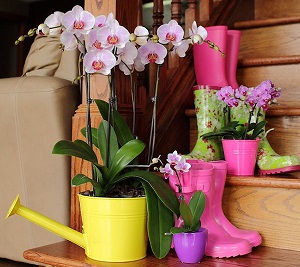 Often, beginners are interested in whether it is possible to water the plant during flowering. Of course, even necessary! If, during flowering, already blossoming flowers wither, this is a signal for irrigation, the substrate is not sufficiently moistened.
Often, beginners are interested in whether it is possible to water the plant during flowering. Of course, even necessary! If, during flowering, already blossoming flowers wither, this is a signal for irrigation, the substrate is not sufficiently moistened.
A constant lack of moisture will shorten the flowering period. Excess moisture causes malnutrition, buds fall off and leaves turn yellow.
Do not disturb the water balance of the plant and feed it during the flowering period.
The ways
The three most common methods for watering epiphytes during flowering are:
- watering from a watering can;
- immersion in water;
- shower strait.
From the watering can
The most common irrigation method. Carried out in the morning. In a thin stream, move the spout of the watering can over the entire surface of the soil until water begins to flow out through the drainage holes. Excess moisture must be removed from the pallet.
Attention! It is important not to allow water to enter the growth points. Blow the water out of your sinuses or collect it with an absorbent tissue
Immersion method
Water is poured into a bath or a deep basin, a pot with an orchid is lowered into it. The water should not reach the edge of the pot 1 cm. Saturation with water occurs in 15-20 minutes. After the water has completely drained, the phalaenopsis is put in its usual place. This watering is enough for 7-10 days.

Watering by immersion method.
Warm shower
The most uneconomical way of straining. It is necessary to repeat the infusion every 1.5-2 weeks. Adjust the pressure and temperature of the water, it should not exceed 45-50 degrees. Watering takes 15-30 minutes.
This method imitates rain for the epiphytes, which they really like. After sprinkling, let the remaining water drain, remove excess water from the sump. This method has an undeniable advantage: dust and dirt are washed off the leaves during the shower.
Water requirements
Use room temperature water in summer and 30-35 ° C in winter. In nature, Phalaenopsis "feed" on rainwater with low acidity. At home, you also need to monitor the hardness of the water. The most favorable water for moistening the soil is rainwater (if you live outside the city, away from roads and factories).
Important! Boil the water before watering the flower. Or use water that has been kept for at least a day
Growing on blocks
Blocks are moistened by immersion. Even frequent, constant watering is not as effective as submersion in water. With normal moistening with a watering can, the water drains very quickly, without having time to saturate the roots with moisture.
Effectively spraying the roots of plants grown on blocks. Use the spray gun 2-3 times a day, using the immersion method 2-3 times a month.
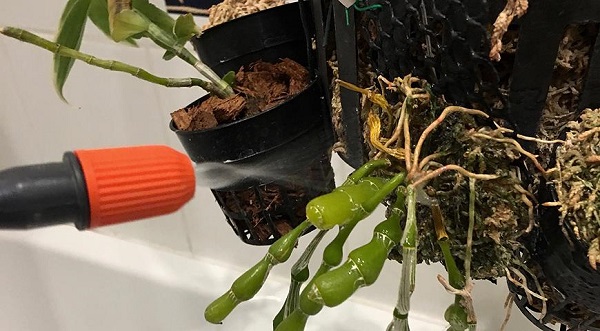
Spraying orchids on blocks is very effective.
Epiphytes do not like dry air, so spraying from a spray bottle will have a positive effect on the appearance, for epiphytes this is an additional way to get moisture. Use soft water. For the prevention of fungal diseases, use Fitosporin solution.
How to water properly?
Winter watering at home should be done with a certain amount of water. Rain or melt is best suited. If such a liquid is not available, you can use boiled water, which has stood for some time.
It is important that there is a lot of oxygen in it. Especially this should be monitored if you need to water a blooming orchid.
In order for the water to have a large amount of oxygen, it is necessary to pour it from one container to another 2-3 times.
During flowering, the plant should be watered very carefully so as not to crush the flowers. For this, watering cans are used. The pressure of the liquid should not be too strong, flow up the soil. It is impossible to touch the sinuses of the leaf plates and the growth points of the flower. You need to stop watering when water begins to flow from the bottom of the pot, where there are special holes. After 2-3 minutes, you need to resume watering. The leaked water should not be used a second time; it should be discarded.
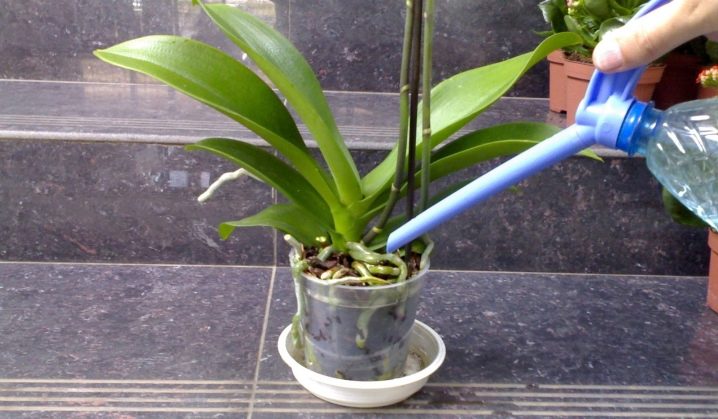
In winter, the humidity in the rooms will be no more than 35%. This is the fault of the heaters, which make the air dry. As a result, various parasites appear and multiply, for example, spider mites.
It is necessary to purchase a special air humidifier that will help maintain an optimal level of humidity and will be useful not only for plants, but also for people living in the house.
There are several other ways to water a plant.
- Immersion. The pot containing the flower should be placed in a bowl of clean liquid. Then you need to wait until the soil is saturated with it, after which the pot is carefully pulled out. The flower grower needs to hold it in weight so that excess water can drain. This method is optimal for plants that are placed in decorative baskets.
- Bathing. This method is also quite simple and effective. It is performed several times a month. You should prepare clean and warm water, the temperature of which will be 20 degrees.The pot in which the plant is located is wrapped in a regular polyethylene bag, and the planting soil is watered with liquid from a tap. Then the orchid is dried and the bag is removed. This method effectively fights against the emergence of pathogenic microorganisms, with the accumulation of dirt, dust and fungal spores.
